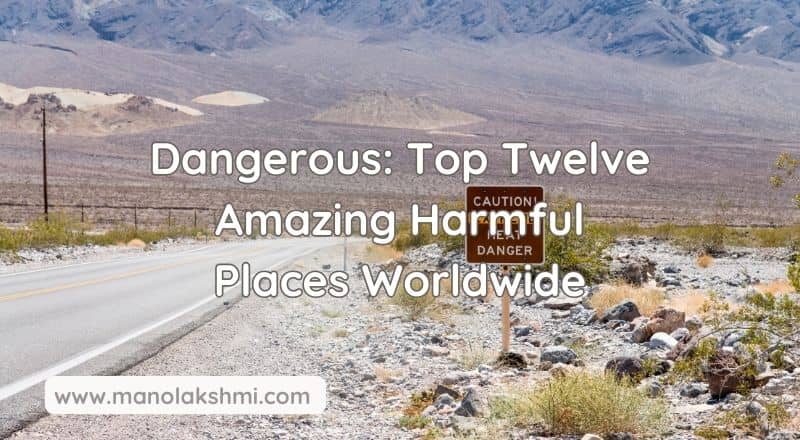Dangerous places, In the realm of perilous places, where danger lurks around every corner, there exist a multitude of locations that inspire awe, caution, and a profound sense of intrigue. From the scorching deserts to the icy tundra, from the depths of the oceans to the heights of the mountains, these places test the limits of human endurance and challenge the boundaries of the unknown.
- North Sentinel Island, India:
- The Danakil Desert, Ethiopia:
- The Skeleton Coast, Namibia:
- The Congo Rainforest, Democratic Republic of the Congo:
- The Amazon Rainforest, Brazil:
- The Kalahari Desert, Botswana:
- The Sahara Desert, North Africa:
- The Gobi Desert, Mongolia: Dangerous
- The Taklamakan Desert, China:
- Antarctica:
- Bermuda Triangle:
- Death Valley: Dangerous
North Sentinel Island, India:
A remote island inhabited by the Sentinelese people, known for their hostility towards outsiders. Visitors are not allowed on the island, and any attempts to make contact with the Sentinelese have been met with violence.
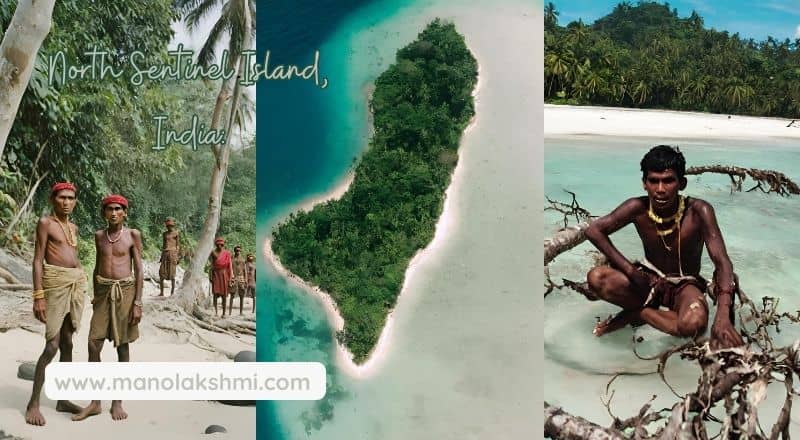
North Sentinel Island – Dangerous
India North Sentinel Island is a small island located in the Andaman Islands, a group of islands in the Bay of Bengal. It is part of India and is known for being home to the Sentinelese people. An indigenous tribe that has had almost no contact with the outside world. The island is off-limits to visitors, and any attempt to approach. It is met with hostility from the Sentinelese.
The Sentinelese, considered the last remaining pre-Neolithic people, are believed to have lived on the island for thousands of years. Their way of life has changed little during that time. They are hunter-gatherers who live in small, temporary settlements. They are skilled fishermen and are also known for their hunting skills.
The Sentinelese are fiercely protective of their island and have a history of violence towards outsiders. In 2006, two fishermen near the island were killed by the Sentinelese. While in 2018, American apostle John Allen Chau was also killed by the same group.
While trying to make contact with them.
The Indian government has declared North Sentinel Island a restricted area, and it is illegal to visit the island without a permit. The government has also taken steps to protect the Sentinelese from outside influences, such as diseases and tourism.
The Sentinelese are fascinating people, and their way of life is a reminder of how different life can be in different parts of the world. Their story is a reminder of the importance of respecting indigenous cultures and the need to protect their way of life.
The Danakil Desert, Ethiopia:
One of the hottest, driest, and most inhospitable places on Earth. The Danakil Desert is home to active volcanoes, boiling springs, and poisonous gasses.
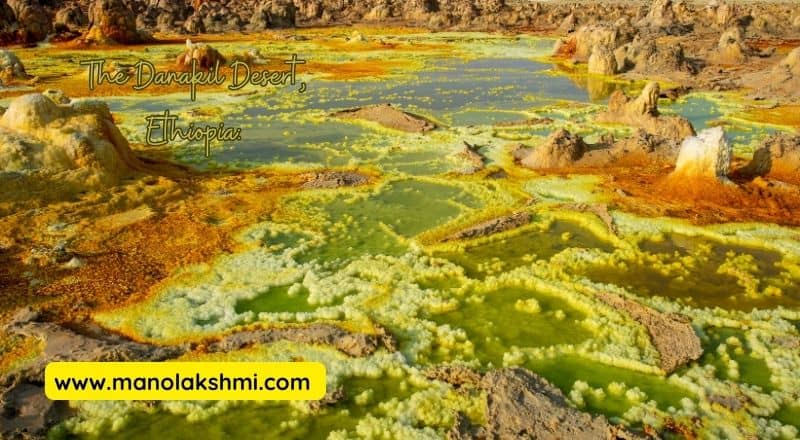
The Danakil Desert, Ethiopia: The Danakil Desert, located in the Afar Region of Ethiopia, is a vast and unforgiving expanse of volcanic terrain, salt flats, and scorching temperatures. It is one of the hottest, driest, and most inhospitable places on Earth, with daytime temperatures regularly exceeding 50 degrees Celsius (122 degrees Fahrenheit).
Here are some more details and expanded information about the Danakil Desert:
Landscape:
The desert is characterized by its unique and otherworldly landscapes, including:
Salt flats: The Danakil Depression contains some of the largest salt flats in the world, such as the Dallol salt flats. These vast expanses of white, crystallized salt create a surreal and stunning visual spectacle.
Volcanic features: The desert is dotted with numerous volcanoes, both active and dormant. The Erta Ale volcano is one of the most active volcanoes in the world, and its lava lake is a mesmerizing sight. Other notable volcanoes include Dallol and Gabuli.
Hot springs: The Danakil Desert is home to several hot springs, including the Dallol hot springs. These springs release colorful and mineral-rich water, creating vibrant and intricate patterns in the surrounding landscape.
Extreme Conditions:
Temperature: The Danakil Desert is known for its extreme temperatures. During the summer months, daytime temperatures can soar up to 55 degrees Celsius (131 degrees Fahrenheit), making it one of the hottest places on the planet.
Rainfall: The desert receives very little rainfall, with an average annual precipitation of less than 100 mm (4 inches). This extreme aridity contributes to the harsh and unforgiving conditions of the desert.
Winds: The Danakil Desert is also known for its strong and steady winds, reaching speeds of up to 80 km/h (50 mph). These winds often carry sand and dust, creating sandstorms and reducing visibility.
Cultural Significance:
Afar people: The Danakil Desert is home to the Afar people, a nomadic ethnic group known for their resilience and adaptability to the harsh desert environment. They have a rich culture and traditions that have been shaped by their unique way of life in the desert.
Mining: The Danakil Desert contains significant mineral resources, including potash, sulfur, and salt. Mining operations are carried out in the desert. Which contributes to the local economy.
The Danakil Desert is a place of extreme beauty and natural wonder but also a land of challenges and hardships. Its harsh conditions and inhospitable environment make it a place that demands respect and caution from those who venture into it.
The Skeleton Coast, Namibia:
A desolate stretch of coastline in southwestern Africa. The Skeleton Coast is known for its shipwrecks, sandstorms, and lack of fresh water.
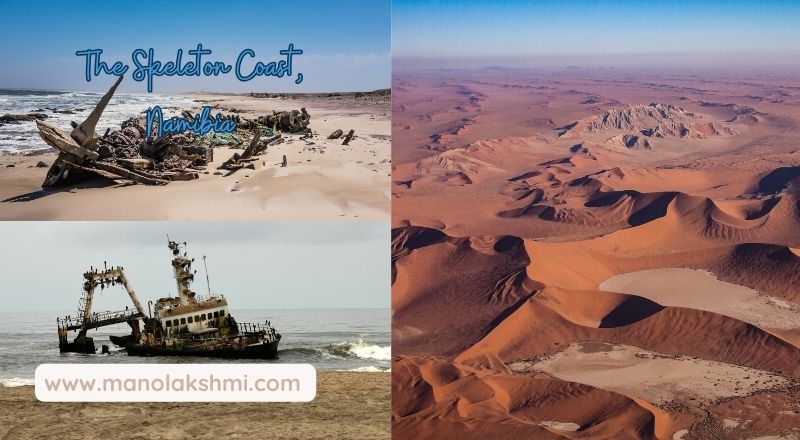
Skeleton Coast, Namibia:
The Skeleton Coast, located in Namibia, is a mesmerizing stretch of coastline known for its haunting beauty and desolate landscapes. Spanning over 500 kilometers, it is a harsh and unforgiving environment. Where the Atlantic Ocean’s cold Benguela Current creates a dense fog that rolls in from the sea, often obscuring the rugged coastline.
The Skeleton Coast earned its eerie name from the numerous shipwrecks that dot its shores. The remains of vessels that met their fate in the treacherous waters. The strong currents, shifting sandbanks, and unpredictable weather conditions have claimed. The lives of countless sailors, leaving behind a somber reminder of the dangers of the sea.
The coastline is typified by its towering dunes. Which rise like sentinels from the barren plains.
These dunes are constantly shifting and reshaping under the influence of the wind, creating a dynamic and ever-changing landscape. The dunes’ colors range from pale gold to deep red, depending on the time of day and the light conditions, adding to the ethereal beauty of the region.
Above the dangerous dunes, the Skeleton Coast is home to a diverse array of wildlife. Counting desert-adapted elephants, lions, giraffes, springboks, and numerous bird species. These animals have adapted to the harsh states of the desert. Relying on the fog for water and finding nutrition in the sparse vegetation.
Despite its desolate appearance, the Skeleton Coast is a place of immense natural beauty. The interplay of the fog, dunes, and wildlife creates. A sense of mystery and wonder attracts visitors from around the world. It is a notice of the power of nature and the fragility of human shots. A place where time seems to stand still and the elements reign supreme.
The Congo Rainforest, Democratic Republic of the Congo:
The largest rainforest in Africa, the Congo Rainforest is home to a variety of dangerous animals, including gorillas, chimpanzees, leopards, and venomous snakes.
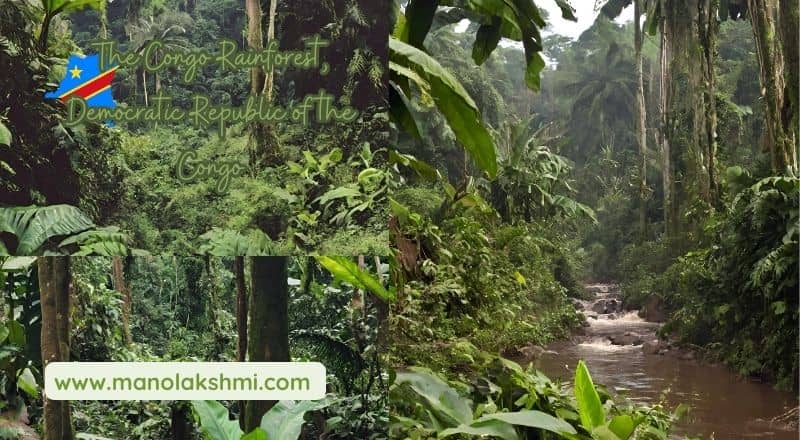
The Congo Rainforest, the second-largest rainforest in the world after the Amazon, holds a vast and diverse ecosystem within the Democratic Republic of the Congo. Spanning over 1.7 million square kilometers, it is a treasure trove of natural wonders and abundant biodiversity.
The Congo Rainforest is home to an incredible array of plant and animal species. It boasts over 10,000 plant species, including rare and endangered species. Such as the African violet, the giant mahogany, and the okoume tree. The rainforest is also a haven for numerous animal species, including endangered species such as the bonobo, the forest elephant, and the okapi.
Beyond its ecological significance, the Congo Rainforest plays a vital role in the lives of the people who live in and around it. The rainforest provides sustenance, shelter, and a source of income for local communities. The people of the Congo Rainforest have developed a deep understanding of the forest and its resources, and have developed traditional practices for sustainable use of the rainforest.
The Congo Rainforest- Dangerous
However, the Congo Rainforest faces significant threats from deforestation, climate change, and illegal activities such as poaching and logging.
Deforestation rates in the Congo Forest are among the highest in the world. Driven by factors such as the growth of farming, logging, and mining. Climate change risks rainforests through varying rainfall patterns and rising diseases. Guiding to biodiversity loss and degraded forest ecosystems.
Conservation efforts in the Congo Rainforest are crucial to protecting its biodiversity and ensuring the sustainable use of its resources. Several conservation organizations and government agencies are working to protect the rainforest, including the World Wildlife Fund (WWF), the Wildlife Conservation Society (WCS), and the Congolese Institute for the Conservation of Nature (ICCN). These organizations are working to combat deforestation, promote sustainable forest management, and raise awareness about the importance of the Congo Rainforest.
The Congo Rainforest is a precious natural heritage that holds immense ecological, cultural, and economic value. Its preservation is essential for the well-being of local communities, the global climate, and future generations.
The Amazon Rainforest, Brazil:
The largest rainforest in the world, the Amazon Rainforest is home to a variety of dangerous animals, including jaguars, anacondas, piranhas, and poisonous frogs.
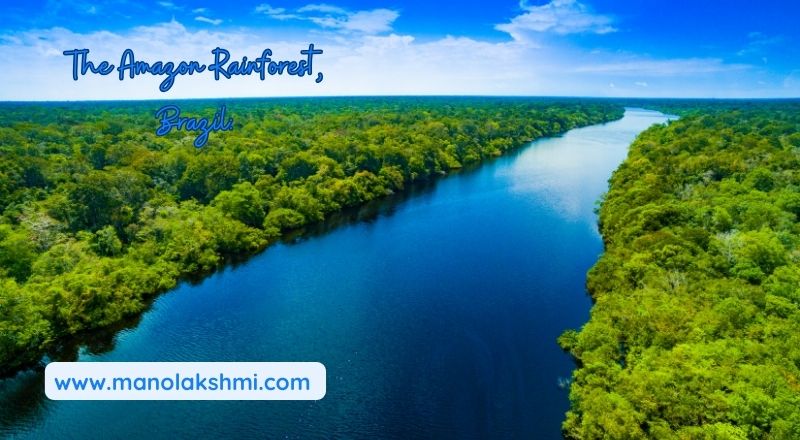
The Amazon rainforest, located in the heart of Brazil, is the largest in the world. Covering an area of over 5.5 million square kilometers. It is home to an incredibly diverse array of plant and animal life. With over 10% of the known species on Earth found within its lush green canopy.
The Amazon rainforest plays a crucial role in regulating. The global climate and is often referred to as the “lungs of the planet” . Due to its immense capacity to absorb carbon dioxide and produce oxygen.
The Amazon rainforest is a vast and complex ecosystem, with a rich tapestry of habitats, including dense rainforests, seasonally flooded forests, and savannas. It is home to over 40,000 plant species, including towering trees such as the kapok and the Brazil nut tree, as well as a wide variety of ferns, orchids, and bromeliads.
The rainforest is also home to an extraordinary array of animal life, including over 1,000 species of birds, 2,500 species of fish, and over 400 species of mammals. Among the most iconic species found in the Amazon rainforest are the jaguar, the howler monkey, the toucan, and the anteater.
The Amazon Rainforest – Dangerous
The Amazon rainforest is home to a diverse range of indigenous peoples, who have lived in the rainforest for thousands of years and have developed a deep understanding of the ecosystem and its resources. The original peoples of the Amazon rainforest have created bearable. living practices that are crucial for the saving of this helpful ecosystem.
Unfortunately, the Amazon rainforest is facing several serious threats, including deforestation, climate change, and pollution. Deforestation is a major problem, as large areas of the rainforest are being cleared for logging, agriculture, and cattle ranching. Climate change is also having a significant impact on the Amazon rainforest, as rising temperatures and changes in rainfall patterns are leading to droughts, fires, and the loss of biodiversity. Pollution from mining and other industrial activities is also harming the rainforest and its inhabitants.
The conservation of the Amazon rainforest is essential for the health of our planet. The rainforest is a vital source of oxygen, water, and biodiversity. It plays a crucial role in regulating the global climate. Protecting the Amazon rainforest is a global responsibility. It requires the cooperation of governments, businesses, and individuals. We must work together to find sustainable ways to live in harmony with the rainforest and to ensure that it continues to thrive for future generations.
The Kalahari Desert, Botswana:
A vast desert in southern Africa, the Kalahari Desert is home to a variety of dangerous animals, including lions, elephants, and black mambas.
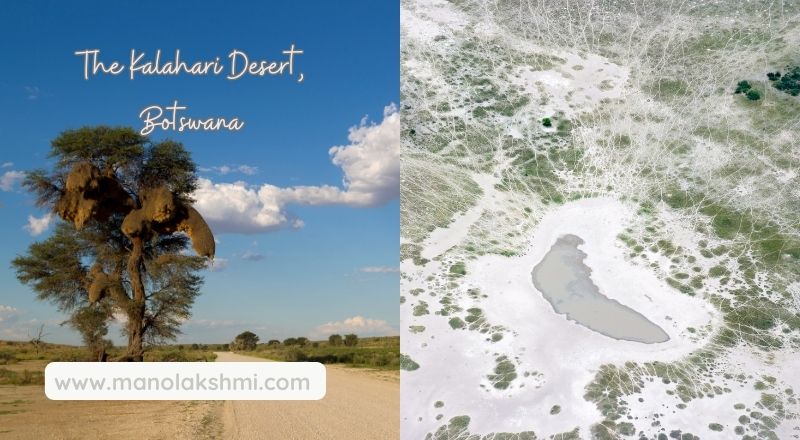
The Kalahari Desert, located in Botswana, is a vast and captivating landscape that stretches across hundreds of thousands of square kilometers. It is a unique blend of arid savannah and semi-desert, characterized by its iconic red sands, towering dunes, and diverse wildlife.
The Kalahari Desert is known for its stunning natural beauty. The red sands, which are composed of ancient windblown deposits. Create a mesmerizing and ever-changing landscape. As the sun moves across the sky, the dunes and plains transform into a kaleidoscope of colors, from golden hues at dawn to vibrant oranges and reds at sunset.
Kalahari Desert- Dangerous
The Kalahari Desert is also home to a wide variety of wildlife. Despite its arid conditions, the desert supports a remarkable array of plant and animal species. The iconic baobab tree, with its distinctive bulbous trunk, is a symbol of the Kalahari. Other notable species include lions, elephants, giraffes, zebras, and springboks.
One of the most remarkable features of the Kalahari Desert is the Okavango Delta, a UNESCO World Heritage Site. This unique wetland oasis is formed by the seasonal flooding of the Okavango River and is a haven for wildlife. The delta teems with aquatic life, including hippos, crocodiles, and a variety of bird species.
The Kalahari Desert is also rich in cultural heritage. It is home to the San people, also known as the Bushmen. Who have lived in the desert for thousands of years. The San people have created a sustainable way of life that is in balance with the natural world. They have a profound grasp of the desert environment.
Visitors to the Kalahari Desert can experience the beauty and tranquility of this unique landscape through a variety of activities. Popular activities include game drives, guided walks, and camping. Several lodges and camps offer a comfortable and authentic desert experience.
The Kalahari Desert is a place of wonder and beauty that offers a glimpse into a world untouched by time. Its vast landscapes, diverse wildlife, and rich cultural heritage make it a truly unforgettable destination.
The Sahara Desert, North Africa:
The largest hot desert in the world, the Sahara Desert is home to a variety of dangerous animals, including scorpions, snakes, and sand vipers.
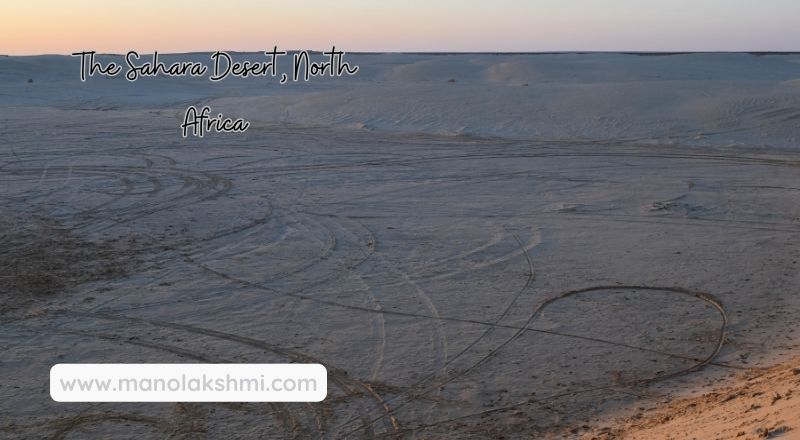
The Sahara Desert, located in North Africa, is the largest hot desert in the world, covering an area of over 9 million square kilometers. A Sahara Desert spans across ten countries, including Algeria, Chad, Egypt, Libya, Mali, Mauritania, Morocco, Niger, Sudan, and Tunisia. The Sahara Desert is known for its vast dunes, which can reach heights of over 180 meters. The desert is also home to a variety of plant and animal life, including date palms, camels, and scorpions.
Sahara Desert
The Sahara Desert is divided into two main regions: the Western Sahara and the Eastern Sahara. The Western Sahara is characterized by its large dunes. While the Eastern Sahara is more rocky and mountainous. The Sahara Desert is also home to several oases. Which are areas of vegetation that are supported by underground water sources.
The Sahara Desert has a long and rich history. It has been inhabited by humans for thousands of years and has been home to several civilizations, including the ancient Egyptians, the Berbers, and the Tuareg. The Sahara Desert has also been a major trade route between North Africa and the Middle East for centuries.
The Sahara Desert is a unique and fascinating place, and it is a popular destination for tourists from all over the world. Visitors to the Sahara Desert can experience a variety of activities, including camel trekking, sandboarding, and camping under the stars. The Sahara Desert is a place of beauty and wonder, and it is a must-see for any traveler.
The Gobi Desert, Mongolia: Dangerous
A vast desert in central Asia, the Gobi Desert is home to a variety of dangerous animals, including camels, wolves, and snow leopards.
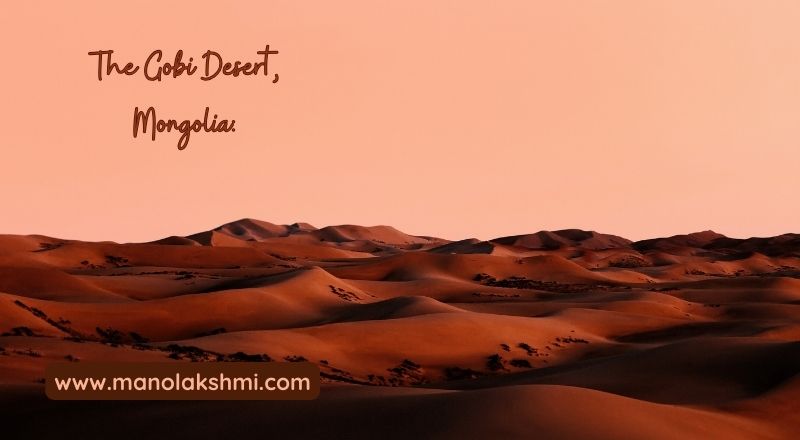
The Gobi Desert, Mongolia, is a vast and captivating landscape that encompasses approximately one-third of the country’s total landmass. Known for its ethereal beauty and rich cultural heritage, the Gobi is a unique destination that offers a glimpse into a world untouched by time. Here, the sands stretch out as far as the eye can see, creating a mesmerizing tapestry of undulating dunes and desolate plains.
Gobi Desert is not just a geographical marvel; it’s also home to a diverse range of wildlife and nomadic communities. Bactrian camels, with their characteristic two humps, can be seen traversing the desert. While elusive snow leopards roam the rugged mountain ranges that flank the region.
The Gobi is also home to numerous bird species, including eagles, falcons, and larks, which soar effortlessly above the desolate landscape.
Gobi Desert- Risky
One of the most fascinating aspects of the Gobi Desert is its rich cultural heritage. The region has been inhabited by nomadic tribes for centuries, and their way of life has remained largely unchanged. Visitors to the Gobi can experience firsthand the traditional lifestyle of these nomadic herders. Who live in portable felt tents called gers and rely on their livestock for sustenance.
Another highlight of the Gobi Desert is the presence of numerous historical and archaeological sites. The region was once a major trade route connecting China and Central Asia. Many ancient ruins and artifacts have been discovered here. Among the most notable sites is the Kharkhorin Erdene Zuu Monastery. A Buddhist monastery founded in the 16th century that is still active today.
The Gobi Desert is a land of contrasts, where the harshness of the environment is juxtaposed with the resilience of life. Whether you’re marveling at the stunning landscapes, observing the wildlife, or immersing yourself in the nomadic culture. A visit to the Gobi Desert is an unforgettable experience that will leave a lasting impression on your soul.
The Taklamakan Desert, China:
A vast desert in western China, the Taklamakan Desert is home to a variety of dangerous animals, including wild camels, bears, and wolves.
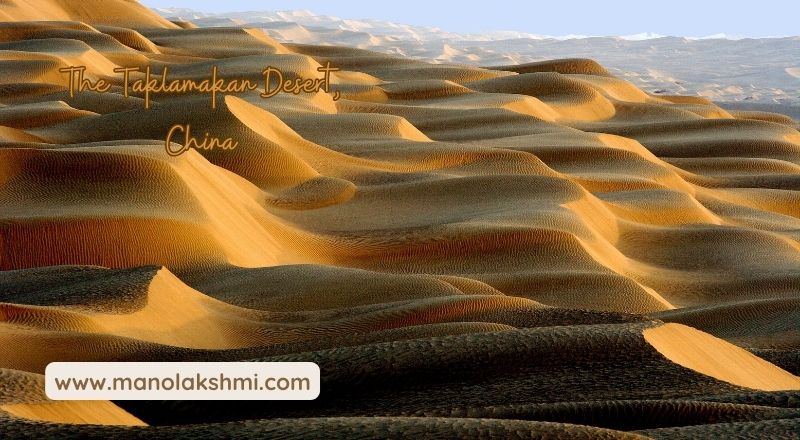
The Taklamakan Desert, a vast and desolate expanse located in the heart of Central Asia, is one of the largest sand deserts in the world. Situated in the Xinjiang Uyghur Autonomous Region of China, the Taklamakan Desert covers an area of approximately 337,000 square kilometers (130,000 square miles), making it slightly larger than Italy.
The Taklamakan Desert is characterized by its extreme aridity. With annual precipitation levels averaging less than 10 millimeters (0.4 inches). The region experiences long, hot summers with temperatures often exceeding 40 degrees Celsius (104 degrees Fahrenheit) and cold winters with temperatures dropping below -20 degrees Celsius (-4 degrees Fahrenheit).
Taklamakan – Dangerous Place
The Taklamakan Desert is home to a variety of plant and animal life that have adapted to the harsh desert conditions. Vegetation is sparse, with the most common plants being shrubs, grasses, and wildflowers. Animals that inhabit the desert include camels, gazelles, hares, and various species of reptiles.
The Taklamakan Desert has a rich history and has been inhabited by various civilizations throughout the centuries. The Silk Road, a network of trade routes that connected China with the West, passed through the Taklamakan Desert, and several ancient cities and towns, such as Khotan, Kashgar, and Yarkand, were located along its path.
The Taklamakan Desert is also home to many archaeological sites, including the ruins of ancient Buddhist monasteries and temples. These sites have yielded valuable insights into the history and culture of the region.
Travelers have been lured to the Taklamakan Desert in recent years. By its unique landscapes and rich cultural legacy. The desert is also a popular destination for scientific research, with scientists studying the region’s ecology, climate, and geology.
Antarctica:
The coldest, driest, and windiest continent on Earth,

Antarctica is home to a variety of dangerous animals, including penguins, seals, and whales.
Antarctica is the fifth-largest continent on Earth.
It is located at the South Pole.
It is covered in ice and snow.
Of all the continents, Antarctica has the lowest temperatures, the least precipitation, and the strongest winds.
It’s home to several species of wildlife, including penguins, seals, and whales.
It is not permanently inhabited by humans.
It is a popular tourist destination.
Click here: Mountains: Ten Amazing Largest Peaks This Worldwide
Bermuda Triangle:
The Bermuda Triangle, also known as the Devil’s Triangle, has fascinated people worldwide for decades. It’s a region in the western part of the North Atlantic Ocean, roughly bounded by Florida, Bermuda, and Puerto Rico. Due to several reported ship and aircraft disappearances, the Bermuda Triangle has developed a reputation as a hazardous and enigmatic location.
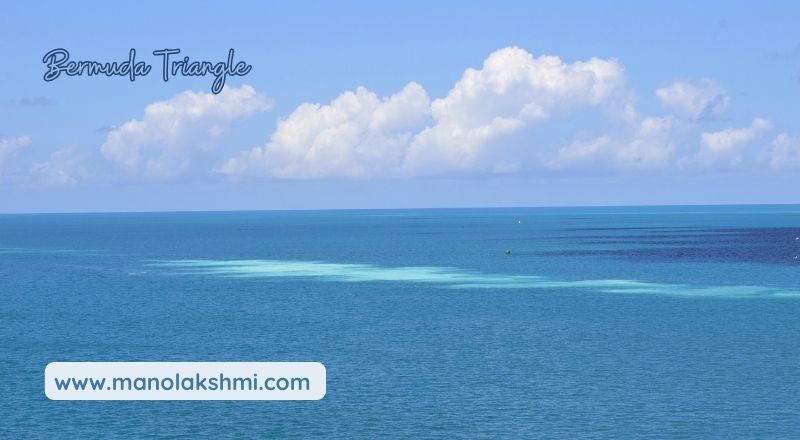
Numerous hypotheses have been put out to account for the Bermuda Triangle abductions. Some people assert that mystical abilities or extraterrestrial abductions are at work in the region. Others believe that magnetic anomalies or methane gas bubbles rising from the ocean floor cause ships and planes to crash.
However, most experts agree there is no single cause for the disappearances, and they are likely due to various factors, including extreme weather conditions, human error, and navigation errors.
Despite various theories, the Bermuda Triangle remains a source of fascination and speculation due to the lack of concrete evidence to support them. Numerous books, documentaries, and movies have been produced. About the mysterious region, keeping the legend alive.
Bermuda Triangle: Dangerous
Here are some of the most famous incidents associated with the Bermuda Triangle:
The disappearance of Flight 19: In December 1945, five U.S. Navy Avenger torpedo bombers, known as Flight 19, vanished without a trace while on a training mission. The planes were never found, and no distress signals were received.
The disappearance of the SS Marine Sulphur Queen: In 1963, the tanker SS Marine Sulphur Queen disappeared off the coast of Florida with a crew of 39. The ship left no trace of its remains or fragments.
The disappearance of the USS Cyclops: In 1918, the U.S. Navy cargo ship USS Cyclops disappeared in the Bermuda Triangle with over 300 people on board. It was the largest single-ship loss in U.S. naval history.
While the Bermuda Triangle has a reputation for being a dangerous and mysterious place. It’s important to note that it is also a heavily trafficked area. With thousands of ships and planes passing through it every year without incident. The vast majority of disappearances that have occurred in the Bermuda Triangle. Can be attributed to natural causes or human error, rather than any paranormal or supernatural phenomena.
Death Valley: Dangerous
Death Valley, situated in the heart of the Mojave Desert, is a land of extremes. It is renowned for being the hottest, driest, and lowest point in North America. The valley, which spans across southeastern California and a small portion of Nevada, offers a unique and captivating landscape that attracts both nature enthusiasts and adventure seekers.
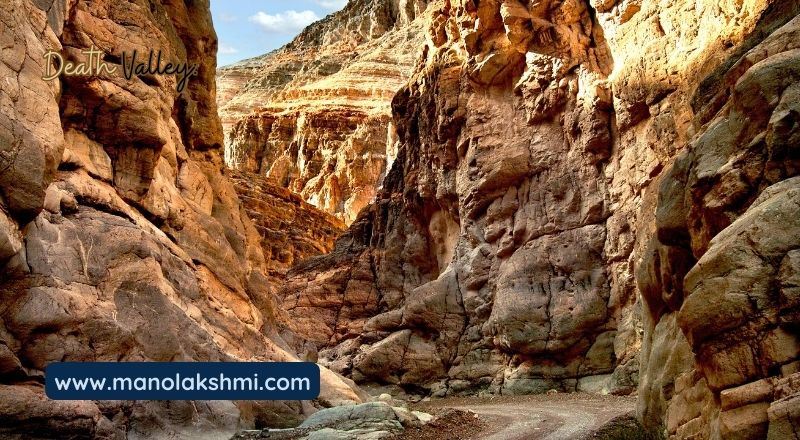
The origins of Death Valley date back millions of years to tectonic shifts that formed the Great Basin. As the landmasses moved, they created a depression that became Death Valley. The valley’s geological history can be seen in its diverse terrain. Which includes towering mountains, vast salt flats, and colorful badlands.
One of the most striking features of Death Valley is its temperature extremes. The valley holds the record for the highest recorded temperature in the world, with a staggering 134°F (56.7°C) measured in 1913.
The low height of the valley is one of the many reasons adding to the intense heat. absence of flora around peaks that keep hot air trapped.
In sharp contrast to the scorching heat, Death Valley is also the driest place in North America. The valley receives an average of less than two inches of rainfall annually, making it a true desert. The lack of moisture has created a unique ecosystem that is home to a variety of adapted plant and animal species.
Death valley Dangerous Place
Despite its harsh conditions, Death Valley is a place of extraordinary beauty. The vast expanse of the valley, punctuated by towering sand dunes, rugged canyons, and colorful rock formations, creates a breathtaking landscape. Visitors can explore the valley’s many attractions, including Badwater Basin. The lowest point in the Western Hemisphere, and Zabriskie Point, which offers panoramic views of the valley.
Dangerous Death Valley also has a rich cultural history. The valley, once home to Native American tribes, is evident in the numerous petroglyphs and artifacts found throughout the area.
In the late 1800s, Death Valley experienced a gold rush, leaving behind abandoned mines and ghost towns that add to the valley’s allure.
Today, Death Valley is a protected area managed by the National Park Service. The park offers a variety of recreational opportunities, including hiking, camping, and stargazing. Visitors can also learn about the valley’s natural and cultural history through interpretive programs and exhibits.
Death Valley is a place of contradictions, where extremes meet and beauty thrives. Its harsh conditions and fragile ecosystem make it a unique and awe-inspiring destination that continues to captivate visitors from around the world.
Click here: Sculptures: The History and Evolution of Sculptures Art in India
